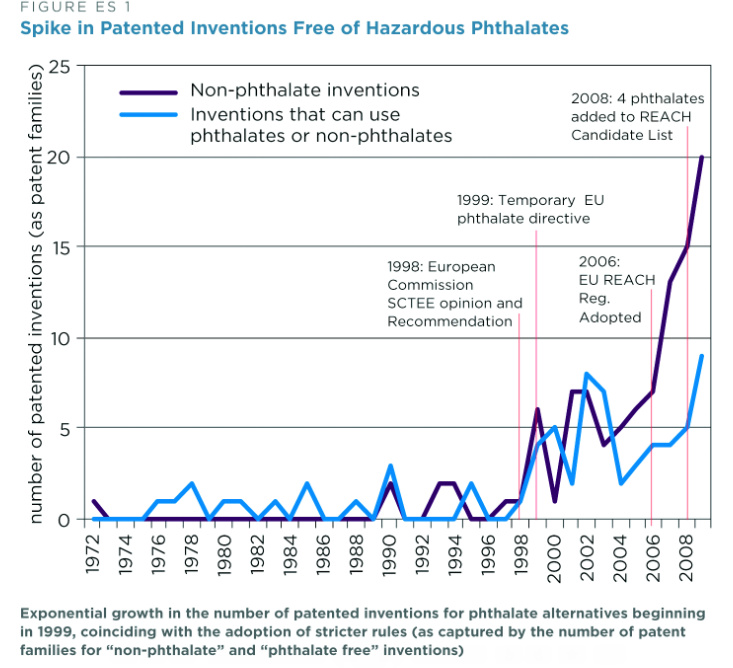How the chemical industry’s rebuttal falls flat
By Baskut Tuncak, orginially posted on the Center for International Environmental Law website.
What are the drivers of innovation? This was the question behind new research CIEL released last week, which clearly illustrates that stronger laws to regulate chemicals are a driver of innovation, and also create a safer marketplace. Forbes broke the story on Wednesday and the report has received attention from policymakers, industry leaders and environmental health advocates alike.
One example of increased innovation following stronger regulations highlighted in our report is this spike in patents for phthalate alternatives after stronger laws were enacted to protect people, especially children, from these widely used plasticizers:
The response from industry groups that seem to prefer the status quo?
“There is no evidence that stricter chemical laws promote innovation,” states one trade association for chemical manufacturers in a Bloomberg BNA article covering our report. We’ve heard this one before, right?
The truth is, innovation is not merely about the invention side of the equation, such as discovering new chemicals and new applications for chemicals, but enabling the adoption of better ideas and ensuring progress towards a healthy environment. In other words, stricter laws increase the supply of and demand for safer alternatives. This is a crucial aspect of how regulation drives innovation in the chemical industry.
The American Chemistry Council (ACC), the trade association for the world’s largest chemicals manufactures, points to a 2012 report for the European Commission (REACH Innovation Report) as proof that regulation stifles innovation. The report cites responses to a survey of companies that 43 percent of companies covered by a European Union chemical regulation program known as REACH reported that the regulation had a negative impact on innovation, compared with 13 percent that said it had a positive effect. But there is more to the REACH Innovation Report than what ACC is letting on.
Five ways the ACC forgot to mention:
1) Nearly half of the companies increased spending on innovation. Among respondents, 46% reported an overall increase “in expenditure on [research and development (R&D)] and other innovative activities.” One of the two reasons cited was that “new opportunities had been opened up due to the coming into force of the Regulation.” In other words, new markets were created, leading to new investment and the potential for new jobs.
2) Companies remain committed to innovation. The REACH Innovation Report’s authors state “despite having to bear the additional costs of REACH, firms have continued to innovate and are keen to continue to do so.”
3) Some large companies report a shift of interest to new substances following REACH. These companies are major spenders in the field of R&D and innovation.
4) The European chemicals industry actually grew following the enactment of REACH. This growth was in spite of the worst economic conditions for Europe in decades in the years after REACH entered into force (2007).
5) Companies are directing their innovation towards safer alternatives. According to the REACH Innovation Report “the survey findings suggest some long term shift in the orientation of R&D towards more health-safety-environment (HSE) goals is occurring…related to the stimulus provided by REACH.”
It is apparent that the survey results cited by the ACC stand in clear contradiction with these overwhelmingly positive aspects of the REACH regulation on chemical innovation in the REACH Innovation Report.
With emerging economies like China overtaking traditional leaders the US and Western Europe in bulk chemical manufacturing, the future of the chemical industry lies not in the status quo mix of chemicals, but instead in businesses that respond to consumer demand by investing in the development of safer chemicals. Policymakers should feel emboldened by our findings to enact stronger laws governing hazardous chemicals that will benefit both the economy and the right to a healthy environment.
The full report Driving Innovation: How stronger laws help bring safer chemicals to market.
Take action NOW!
To follow CIEL on Twitter: @ciel_tweets





